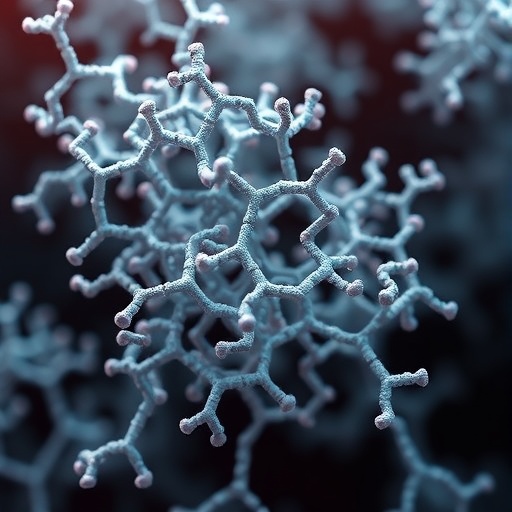In an exciting development in the field of microbiology and pharmacology, researchers studying the geothermal soils of Indonesia have uncovered a remarkable treasure trove of new compounds from a lesser-known genus of actinomycetes known as Gandjariella. These findings bring forth three newly identified glycosylated anthracyclines, designated mutactimycins H, I, and J, alongside the well-documented mutactimycin E. This discovery is particularly significant given the increasing global concern regarding antibiotic resistance, especially in the context of mycobacterial infections.
The scientific team led by D.W. Triningsih, in collaboration with notable colleagues including S. Kimachi and F. Ningsih, embarked on chemical explorations aimed at uncovering new antibacterial agents from the biodiverse habitats found in geothermal regions. Their efforts have paid off, resulting in the extraction and identification of these structurally unique anthracyclines. This class of compounds, known for its utility in a broad range of therapeutic applications, has new representatives that might prove vital in the ongoing fight against drug-resistant bacteria.
Through a combination of intricate spectroscopic analyses and chemical degradation methodologies, the structures of mutactimycins H–J were elucidated. The methodologies employed included Nuclear Magnetic Resonance (NMR) and Mass Spectrometry (MS), which are essential techniques in the toolbox of modern synthetic chemistry. These methods allowed the researchers to construct a detailed picture of the molecular architecture of these new compounds, revealing the complex interrelationships between their glycosyl moieties and aglycone components.
Antimicrobial activity testing was central to the significance of this research, as Mycobacterium species pose a significant challenge to global health. The newly isolated compounds were subjected to minimum inhibitory concentration (MIC) testing, revealing impressive antibacterial properties across four different Mycobacterium species. With MIC values ranging from 3.13 to 50 μg/mL, mutactimycins H–J show promising potential as effective therapeutic agents, particularly in a landscape where resistance to existing drugs is alarmingly prevalent.
The team has positioned their findings within the broader context of antibiotic discovery, highlighting the need for novel compounds to combat multi-drug resistant strains of Mycobacterium tuberculosis. The urgency of this research aligns with global efforts to innovate in the face of rising antibiotic resistance, with natural products often serving as key inspirations for new pharmaceuticals.
As such, the research undertaken by Triningsih and her colleagues opens a new chapter in the exploration of therapeutic opportunities presented by geothermal environments. These unique habitats are increasingly being recognized as promising sources of bioactive compounds owing to their distinct microbial communities, which have adapted to harsh conditions and may harbor novel biosynthetic capabilities.
The implications of the study are vast. Isolation of new compounds such as mutactimycins H–J may lead to the development of novel treatment protocols that leverage their unique antibacterial properties in conjunction with existing therapies. Moreover, understanding the mechanisms by which these compounds exert their effects could provide deeper insights into microbial resistance mechanisms, paving the way for smarter drug design.
Critical to the success of such endeavors is an interdisciplinary approach that merges microbiology, chemistry, pharmacology, and clinical research. Future research aimed at deciphering the full range of biological activities exhibited by mutactimycins may promote synergy when combined with other therapeutic agents, ultimately refining treatment paradigms for mycobacterial infections.
As we reflect on the potential of this new class of compounds, it becomes evident that they might serve not only as standalone therapeutics but also as benchmark agents to guide future drug discovery efforts. Exemplifying the intricate interplay between natural ecosystems and human health, the study encapsulates the essence of bioscience research, wherein exploration of our planet’s biodiversity can yield unexpected yet impactful medical advancements.
In conclusion, the discovery of mutactimycins H–J from Gandjariella species exemplifies how untapped natural resources can provide viable pathways toward combatting the pressing challenge of antibiotic resistance. This research, highlighting the antimicrobial properties of these newly characterized anthracyclines, reinforces the need for continued exploration of extreme environments, unveiling their potential in the ongoing quest to develop effective pharmaceutical interventions that could save lives.
The global scientific community eagerly awaits further studies that will investigate the structural diversities and mechanisms of action of these newly discovered compounds. With the right focus and resources, the potential for Gandjariella species to contribute to novel treatment options appears promising, making this area of research especially vibrant and crucial in today’s health landscape.
Subject of Research: Isolation and characterization of glycosylated anthracyclines from Gandjariella species.
Article Title: Mutactimycins H–J, antimycobacterial anthracyclines, from a thermophilic actinomycete of the genus Gandjariella.
Article References: Triningsih, D.W., Kimachi, S., Ningsih, F. et al. Mutactimycins H–J, antimycobacterial anthracyclines, from a thermophilic actinomycete of the genus Gandjariella. J Antibiot 78, 651–658 (2025). https://doi.org/10.1038/s41429-025-00858-z
Image Credits: AI Generated
DOI: October 2025
Keywords: Gandjariella, glycosylated anthracyclines, mutactimycin, antibacterial, Mycobacterium, antibiotic resistance, geothermal soils, natural products.




